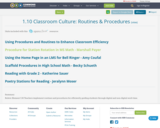
Rubric Element 1.10 Teachers implement routines and procedures for efficiently guiding students through digital and non-digital work time.
- Subject:
- Education
- Material Type:
- Primary Source
- Date Added:
- 07/20/2018

Rubric Element 1.10 Teachers implement routines and procedures for efficiently guiding students through digital and non-digital work time.
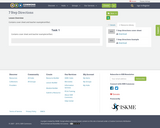
Contains cover sheet and teacher example/artifact.
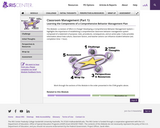
This Module—a revision of Who's In Charge? Developing a Comprehensive Behavior Management System—highlights the importance of establishing a comprehensive classroom behavior management system composed of a statement of purpose, rules, procedures, consequences, and an action plan. It also provides information about how culture, classroom factors, and teacher actions can influence student behavior (est. completion time: 1 hour).

This Module—a revision of You're in Charge! Developing Your Own Comprehensive Behavior Management Plan—reviews the major components of classroom management (including rules, procedures, and consequences) and guides users through the steps of creating their own comprehensive behavior plan. The module is a companion to Classroom Management (Part 1): Learning the Components of a Comprehensive Behavior Management Plan (est. completion time: 2 hours).

This course introduces architecture of digital systems, emphasizing structural principles common to a wide range of technologies. It covers the topics including multilevel implementation strategies, definition of new primitives (e.g., gates, instructions, procedures, processes) and their mechanization using lower-level elements. It also includes analysis of potential concurrency, precedence constraints and performance measures, pipelined and multidimensional systems, instruction set design issues and architectural support for contemporary software structures.

6.004 offers an introduction to the engineering of digital systems. Starting with MOS transistors, the course develops a series of building blocks — logic gates, combinational and sequential circuits, finite-state machines, computers and finally complete systems. Both hardware and software mechanisms are explored through a series of design examples.
6.004 is required material for any EECS undergraduate who wants to understand (and ultimately design) digital systems. A good grasp of the material is essential for later courses in digital design, computer architecture and systems. The problem sets and lab exercises are intended to give students “hands-on” experience in designing digital systems; each student completes a gate-level design for a reduced instruction set computer (RISC) processor during the semester.

Students are introduced to safety protocols by evaluating unsafe situations, sharing their ideas with their peers, developing a list of recommended safety protocols as a class, and finally, by comparing the class list to a standard list of safety rules. This activity seeks to demonstrate the importance of safety engineering and illustrate how it helps to prevent injuries and save lives. A PowerPoint® presentation, pre/post quiz and student handout are provided.
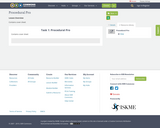
Contains cover sheet

Students will complete a procedural writing project researching a topic of their choice. The students will use GSuite Tools to access and complete their drafts. The students will present their final procedural writing draft by creating an infographic in Canva displaying their work through text and images.
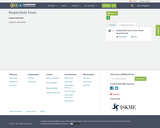
Contains cover sheet

This course introduces students to the principles of computation. Upon completion of 6.001, students should be able to explain and apply the basic methods from programming languages to analyze computational systems, and to generate computational solutions to abstract problems. Substantial weekly programming assignments are an integral part of the course. This course is worth 4 Engineering Design Points.